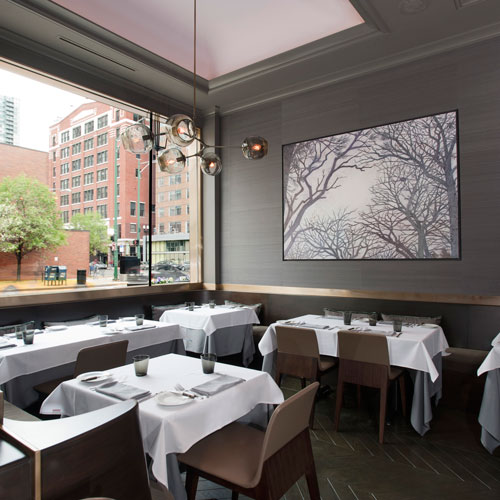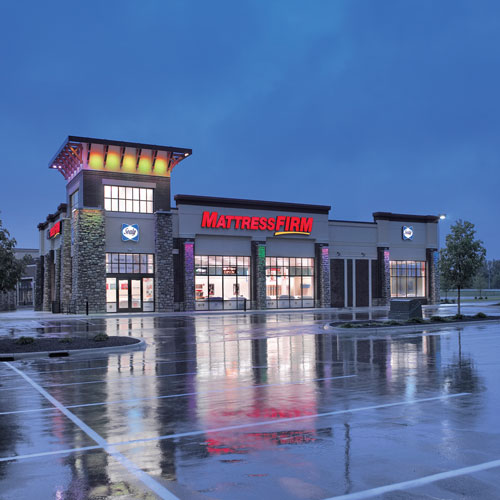
—Julienne Smith, Senior VP of Development in North America (Portrait: Sheila Barabad)
When Julienne Smith was hired by Hyatt in 2005, her goal was to launch a select-service, upscale brand that could extend and deepen Hyatt’s footprint in cities such as Richmond, Virginia, and Charlotte, North Carolina. There, the multi-billion dollar hospitality brand was losing customers to competitors such as Courtyard by Marriott, Hilton Garden Inn, Homewood Suites, and Residence Inn.
“When I came to Hyatt, we had just over 200 hotels worldwide,” she says. “That was a shockingly low number from my standpoint. We really wanted to satisfy customer needs, to do more than our competitors and really focus and study who the consumer is. We wanted to appeal to the business traveler making a quick in and out in Richmond, Virginia: the same customer who is staying with us when they take their kids to a soccer tournament, attending a conference at a Hyatt Regency, and using their Hyatt Gold Passport points for a Kauai vacation.”
In the House
Hyatt House is an extended-stay, upscale hotel. It attracts a similar customer, but one who plans on staying five or more nights. Also highly variable, the standard model is four-story stick construction, on a 20,000-square-foot footprint and surface parking lot contained within a 2.5-acre plot. Guests might be recovering from surgery, relocating because of a job transfer, or renovating their house. About 70 percent of the rooms are one-bedroom kitchen suites. Many rooms can be opened into a two-bedroom suite.
Really, Smith has two jobs. Her main responsibility is to oversee a team of developers that are helping to grow the Hyatt Place and Hyatt House brands in North America. She assists them in selecting site locations—typically in urban, medical, and college markets—and negotiating contracts with new or existing franchisees seeking to open select-service units. Her other job is to drive demand for the select-service brands by serving as their spokeswoman at panels and conferences, where she tells Hyatt’s story.
That story begins with people. “We are a purpose-driven, brand-led organization,” Smith says. “We put customers first. We care for our colleagues, guests, owners, and franchisees. When [Hyatt Hotel creator] Jay Pritzker embarked on his first hotel venture in Los Angeles, he decided to create a brand before ‘brand’ was really talked about, and we’re carrying on that legacy. We’re not trying to be the biggest hotel company. We’re not trying to add a thousand units by ‘X’ date. We’re trying to grow with the right partners, aligned with our purpose and vision, to become the most preferred hotel company.”
Still, the Hyatt Place and Hyatt House brands are growing rapidly, both in the United States and abroad. Today, there are more than 290 operating locations between the two names, with 100 executed contracts for Hyatt Place and Hyatt House hotels around the world; 40 percent of the company’s pipeline consists of select service hotels, half of which are outside the US.
Hyatt Place received a major bump when it acquired and converted 120 AmeriSuites hotels, expanding its footprint in outlying suburbs across the United States. In addition to that, new select-service locations have opened in China, Panama, Chile, Mexico, Armenia, and India. “We want to grow where investors are buying,” Smith says, “whether that’s a four-story stick in Tyler, Texas, or a 27-story structure in Manhattan.”
The Place To Be
Hyatt Place is an upscale select service brand. It caters to the “road warrior” business traveler making a one-to-two day stopover and families traveling on weekends. Although most locations are built to suit and can range in size and room count, the prototype is a 85,000-square-foot, six-story, block-and-plank mid-rise sitting on a 20,000-square-foot footprint. Typical amenities include a pool, a 24-hour fitness center, free Wi-Fi, complimentary breakfast in a gallery-style lobby, and a full bar with beer, wine, and liquor. At 300 square feet, the rooms are spacious by hotel standards and include a pullout sofa sleeper and divider panel that separates the bedroom from the seating area. “The rooms are a category killer from our vantage point. They’re why the brand was recognized by J.D. Power as highest in guest satisfaction among upscale hotel chains,” Smith says.
Finding where those investors are buying—and installing Hyatt in the right locations with the right franchisers—is where Smith says she excels: “It’s not rocket science. You look at demand generators, universities, corporate centers, hospitals that have a large regional draw. And balance that with support amenities. Guests today would rather be in a hotel next to retail, restaurants, and dining, and not get in a car.”
The other thing modern travelers crave—and what differentiates Hyatt Place and Hyatt House from its competitors, Smith says—is a fresher, all-inclusive experience that feels like home. “We take the Hyatt DNA of welcoming everyone and balance it with a contemporary design that is more relevant to customers,” she says.
For franchisees, the allure of investment, according to Smith, is that they often manage the sole location in a given city, which means they don’t have to compete with other hotels under the same banner. Also, because Hyatt builds and develops its own hotels, investors benefit from time-tested analysis of customer preferences for room sizes, amenities, and layouts across a vast portfolio. She says a large part of Hyatt’s portfolio is comprised of loyal franchisees who own multiple locations.
The process is not without its challenges, though. Six- to seven-year real estate cycles can make lending tight at critical times, according to Smith. Though select-service hotels are more resilient than luxury hotels to abrupt market turns, they certainly are not immune. Hotel development can also be seen as volatile among lenders because you don’t see income until guests begin to check in after the opening. When she first came aboard, some colleagues were puzzled over how she would translate the Hyatt brand to a select-service model without diluting it—a question that has been happily answered, for example, in parallel service options and the use of the same Hyatt Grand Bed mattress in a Hyatt Place as in a Park Hyatt hotel.

One of the biggest challenges of late is keeping a close eye on Airbnb, the San Francisco-based online hosting site that allows property owners to rent their spaces to guests for short-term stays. The company’s rapid growth into almost every major city—with virtually no real estate holdings—is a cause for concern to Smith, as is the personal connection some hosts make with their guests. Still, she says the Hyatt select-service brands offer something Airbnb doesn’t: consistency. “I think the strength of our brands is that we can deliver a promise that meets our customer’s expectations,” she says. “Where we’ll come out ahead is by offering an environment of care that can be counted on at every location.”


